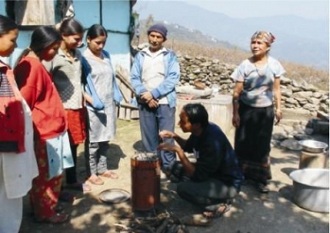Integrated Evaluation of Smoke Exposure, Health Impacts and User Satisfaction of an Improved Cookstove Intervention, 2012.
Alexander, Donee. Thesis (Ph.D.)–University of Washington, 2012.
To date, no standard questionnaire exists to evaluate respiratory health related to improved cookstove intervention, and few studies evaluating the health effects of indoor air pollution have conducted spirometry or blood pressure measurements in their assessment. Moreover, studies that have evaluated the associations between improved lung function and blood pressure, and cookstove interventions have yielded inconsistent results. Research has shown that improved biomass cookstoves with ventilation systems significantly reduce exposure to indoor air pollution. However, experience in community development has shown that improved technology does not guarantee usage.
Through an iterative process, this research sought to design a stove that met both technical criteria of efficiency and emissions and was well accepted by users. The study also evaluated the pulmonary and cardiovascular health effects of an improved cookstove technology on indigenous women living in rural Bolivia. Based on random home visits and post-intervention questionnaire responses, over 90% of users adopted the improved cookstove technology. Reductions of approximately 80% were seen for 24-hour mean CO and PM levels, as well as mean cooking and peak PM levels one year post-intervention.
Yanayo stove implementation resulted in significantly improved (lower) St. George’s Repiriatory Quality of Life (SGRQ) Total scores as well as Activity and Impact scores. Overall differences in pre- and post-intervention SGRQ Symptoms scores were not statistically significant. However, a number of individual question scores in this category were significantly lower in women post-implementation of the Yanayo stove.
Mean improvements of FEV1 from 1.95 L (± 0.6) to 2.15 L (± 0.7), p < 0.005 were seen post-intervention. Improvements in FVC and FEV1/FVC were also seen, but these changes were not significant. Mean systolic blood pressure (SBP) decreased from 114.5 mm Hg (± 13) to 109.0 mm Hg (± 9), (p = 0.014). Decreases in diastolic blood pressure (DBP) were also seen, but these changes were not significant. Decreases in SBP were correlated with 24-hour, mean kitchen PM levels (µg/m3) (R = 0.587, p = 0.035). Somewhat stronger correlations were found between reductions in cooking PM concentrations (µg/m3) and reductions in both SBP (R = 0.662, p = 0.014) and DBP (R = 0.658, p = 0.014).
This is the first study to observe significant improvements in lung function post implementation of an improved cookstove and the first to find associations between decreases in both 24-hour mean and mean cooking PM levels and decreases in SBP following an improved cookstove intervention.



